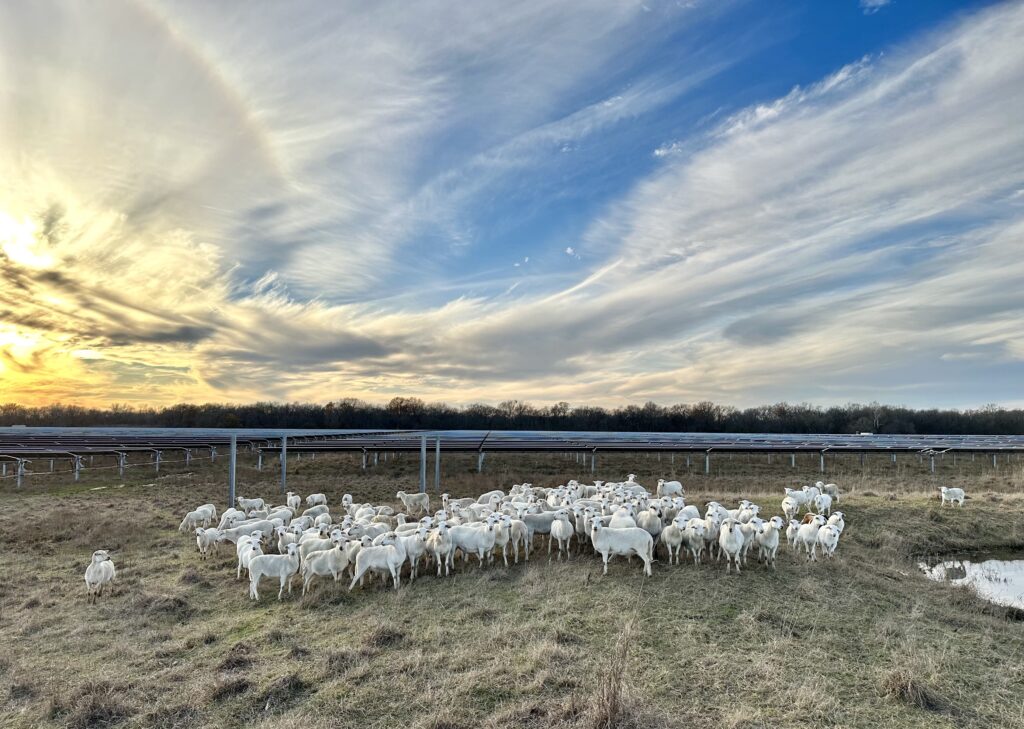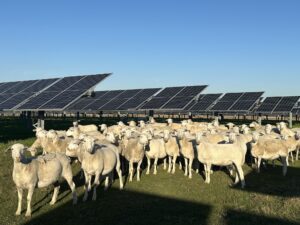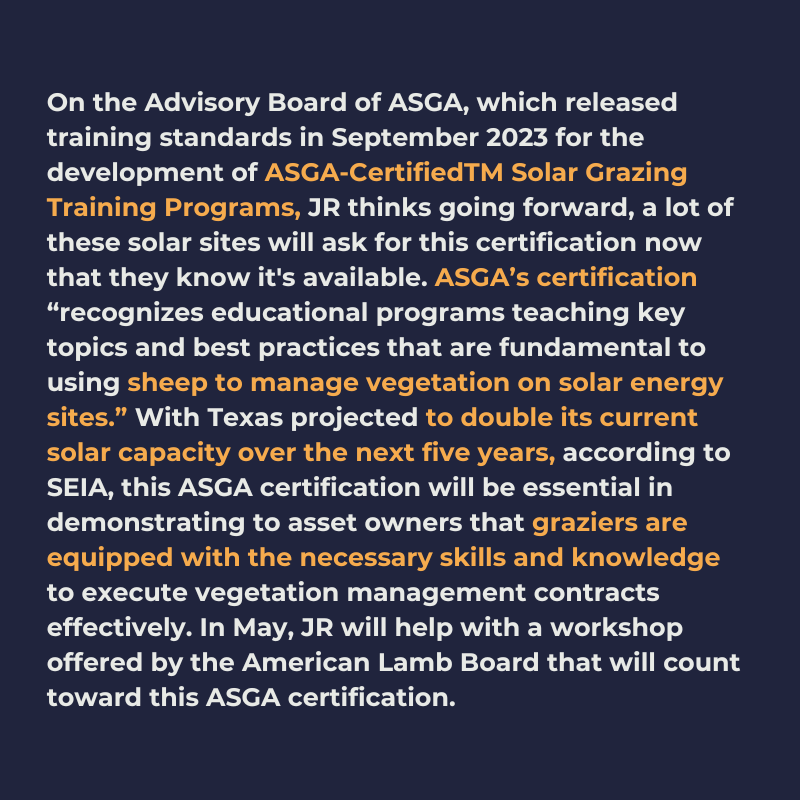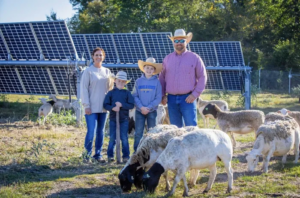Texas Solar Sheep is Creating a Bright Future for Agrivoltaics in Texas

Long known as a major energy producer, Texas now leads the nation with the most installed utility-scale solar capacity with no sign of slowing down. As these large solar farms increase around the state and the country, many solar developers are increasingly partnering with farmers who use their flocks of animals as a vegetation management tool. If done well, this shift in management can help increase soil quality, sequester carbon, and decrease operating and maintenance costs for solar developers. But perhaps most importantly, the dual use of land for energy and agricultural production—known as “agrivoltaics”—can also provide opportunities for farmers to grow, expand, and start successful farm businesses.
JR Howard is a great example of one of these farmers. Based northeast of Dallas, Texas, in Lamar County, JR and, his family run Texas Solar Sheep, a growing solar grazing company that specializes in vegetation management on large utility-scale solar sites. With a family flock of around 300 ewes, he didn’t know much about large-scale solar grazing when he was first asked to look into it back in 2020. Most resources were then geared toward graziers on smaller 5–15-acre sites, not thousand-acre sites that were becoming increasingly common in higher rainfall areas. Resources from the American Solar Grazing Association (ASGA), support from fellow graziers, an entrepreneurial attitude, and perseverance allowed JR to gain a foothold in the solar grazing industry. His reputation for going above and beyond on every site has allowed partnerships with solar companies to flourish, providing JR’s family with access to land and the opportunity to rapidly expand their sheep operation. Leaning on prior work experience in large-scale logistics operations, JR now manages over 5,000 ewes and expects these numbers to double in 2024.

To help grow his family’s solar grazing business, JR applied for and received a grant from American Farmland Trust’s Brighter Future Fund in 2023. The Brighter Future Fund grew out of a pandemic-era grant program designed to provide critical financial support to farmers when many direct market sales venues like schools, restaurants, and farmers markets shut down in 2020. Since that initial grant round, AFT has awarded nearly $3 million to 470 farmers and ranchers in all fifty states and four territories, enabling the pursuit of innovative solutions and business objectives while positively impacting communities. “This grant will help us be more efficient in working our rotational grazing program on solar farms,” said JR, by reducing his pasture size in half, down to 50–60-acre blocks. JR will be able to demonstrate how rotational grazing works and what it looks like to the graziers, asset managers, and other visitors who join one of the forty tours he gives annually.
These tours are just one area that confirms JR’s desire to help others and keep this industry moving in the right direction. Solar developers regularly seek his advice on how to best design sites to implement grazing programs and cut down on their vegetation management costs, the largest ongoing expense once a site is built. If the site can be set up to accommodate grazing livestock, savings from a reduction in labor and other costs incurred by the solar grazier can be passed along to the asset owner. Many developers are beginning to include cross fencing, water lines, and internal gates in their site plans. By frontloading these expenses on the construction side, they can take advantage of government incentives and reduce their ongoing operations and maintenance costs throughout the duration of the lease. Unlike when he first started, JR says that “it’s fun to see it evolve from basically no buy in to now thinking about in construction and trying to set up the right way for grazing and other activities.”
Overcoming hesitations through trust building and demonstrating impact have enabled JR to diversify on-site agricultural production by combining grazing, producing lamb meat for market, and adding some no-till seeding for increased forage and hay production. Most sites have extra land leased around the edges due to setbacks or power lines running through the property. This provides opportunities to capitalize on land under contract and implement more agrivoltaic scenarios. Utilizing this extra land helps JR cut down on his hay bill, improving the budget for that site, allowing him to pass those savings back to the asset managers.

Texas Solar Sheep uses local labor and vendors to impact the rural economies they serve, with JR regularly highlighting small businesses on his social media platforms. An advocate for other graziers wanting to get started with solar grazing, JR is working with cooperating producers, helping some access small plots as they gain experience and expand. He has spoken at over a dozen events in the last year to share his experiences and offer advice. Most of his sites are in the higher rainfall areas stretching along the I35 corridor from Waco to northeast of Dallas.
This unprecedented growth has led to many concerns, specifically regarding safeguarding land well-suited for farming and ranching. If done with intention, future growth in utility-scale solar developments can bring new opportunities to beginning and established farmers while supporting the local communities where these projects are located. Long an advocate for protecting farmland, promoting sound agricultural practices, and keeping farmers on the land, AFT developed Smart SolarSM principles to guide solar development as it expands around the country. With more strategic and intentional planning, the placement of solar projects can safeguard land for farming and ranching by protecting soil health, expanding agrivoltaics for agricultural production and solar energy, and strengthening farm viability. By advancing these principles, Texas farmlands can contribute significantly to the adoption of solar energy without compromising active and productive agricultural systems. Given that Texas is the largest producer of sheep in the country and our utility-scale solar is growing so rapidly, there is tremendous potential for agrivoltaics expansion. Not only has this renewable energy development benefited beginning solar graziers and businesses such as Texas Solar Sheep, but it has created additional revenue streams for landowners that host these sites. Just as previous lease payments for oil, gas, and wind have benefited Texas landowners, if done well, solar developments can do the same.

Smart Solar and the Brighter Future Fund are just two important examples of the many ways AFT is a leader when it comes to strengthening farm viability. Early solar graziers will set the standard for those who follow and influence how solar developers integrate this type of vegetation management strategy into their operations. The Department of Energy, in their 2021 Solar Futures Study, estimated that we will need over 10 million acres of land by 2050 to reach our decarbonization goals. With 90% of this solar development expected to be in rural areas, it is important to our agricultural land base and the communities they support that we get this right. If Texas Solar Sheep is the example to follow, the future surely looks bright in Texas.

